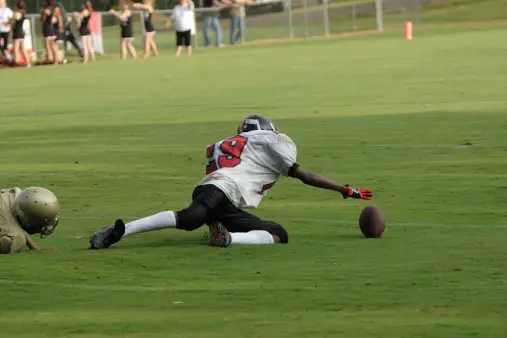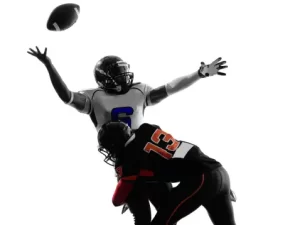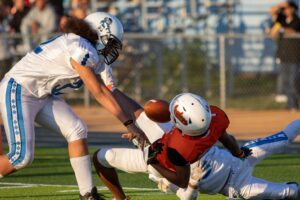Lots of excitement happens in football when there’s a turnover. Turnovers play a crucial role in determining the outcome of a game. A turnover occurs when a team loses possession of the ball, allowing the opposing team to gain control and potentially increase their chances of scoring. This article will delve into the intricacies of football turnovers, focusing on fumbles and interceptions – the two events officially classified as turnovers. What is a turnover in Football?
Fumbles and interceptions are significant for both the offense and defense and have the potential to shift the momentum of a game. When a defense is successful in forcing a turnover, they not only halt the offense’s progress but also create an opportunity for their team to score. Similarly, when the offense fumbles the ball or throws an interception, they face the consequences of potentially losing points, which could be the deciding factor in a tightly contested match.
As we explore the concept of turnovers in football, we will examine how they occur, their impact on game dynamics, and the strategies employed by teams to both force and prevent them. By understanding turnovers, one can appreciate the importance of ball possession, the influence of a strong defense, and the skill required to maintain control over the course of a game.
Contents
Understanding Turnovers
A turnover in football is an event where possession of the ball switches from one team to another. Turnovers can significantly impact the outcome of a game, as they provide an opportunity for the team receiving the turnover to score. There are two primary types of turnovers: interceptions and fumbles.
Interceptions
An interception occurs when a pass intended for a member of the offensive team is caught by a member of the defensive team. This can happen for various reasons, such as a poorly thrown pass, a deflected pass, or an exceptionally well-played defensive move. Here are some key aspects of interceptions:
- Usually, the result of a passing play
- Can significantly change the momentum of the game
- Often occur when the quarterback is under pressure or makes an ill-advised throw
Fumbles
A fumble is another type of turnover, and it happens when a player with possession of the ball loses control of it before being tackled or going out of bounds. Defensive players can force a fumble with hard hits or by stripping the ball away from the ball carrier. Here are some essential elements of fumbles:
- Can occur during running, passing, or special teams plays
- More likely to happen when a player is hit while changing direction or while holding the ball loosely
- Recovery of a fumble is a critical aspect, as the team that recovers the ball takes possession
Understanding turnovers is crucial for both players and fans, as they can dramatically alter the course of a game. While interceptions and fumbles are the most common types of turnovers, other events, like turnover on downs or blocked kicks, can also lead to changes in possession. Ultimately, protecting the ball and forcing turnovers are both vital strategies for a team’s success on the field.
Causes of Turnovers
Turnovers in football are crucial events that can significantly alter the course of a game. They occur when the offensive team loses possession of the ball to the defensive team. There are several factors that can contribute to turnovers in football, which we will explore in this section.
Pressure on Quarterback
One primary cause of turnovers is the pressure exerted on the quarterback by the defensive players. When a quarterback feels overwhelmed by the defense, they may make hasty decisions, leading to interceptions or fumbles. Examples of situations where pressure can lead to turnovers include:
- Sacks: When the quarterback is tackled by a defensive player before he can release the ball
- Forced throws: The quarterback rushes their throw due to the imminent threat from defensive players
- Hurried passes: The quarterback doesn’t have the time to make accurate throws due to defensive pressure
Mishandled Handoffs
Another common source of turnovers in football is mishandled handoffs between the quarterback and the running back. A smooth handoff is essential for successful offensive play, but sometimes errors occur, leading to fumbles. Some potential reasons for mishandled handoffs include:
- Poor communication between the QB and RB
- Lack of proper technique in executing the handoff
- Environmental factors, such as wet or slippery conditions
Good Defensive Plays
Lastly, a well-executed play by the defensive team can also result in a turnover. Skilled and aware defensive players can capitalize on opportunities to steal the ball from the offense by:
- Interceptions: When a defender catches a pass intended for an offensive player
- Forced fumbles: The act of stripping or knocking the ball out of the ball carrier’s hands
- Recovered fumbles: The defensive team successfully recovers a loose ball after a fumble or muffed punt
In conclusion, turnovers in football stem from various factors, including pressure on the quarterback, mishandled handoffs, and good defensive plays. Understanding these causes can help teams strategize and develop tactics to minimize turnovers and maximize their chances of success on the field.
Turnover Impact on Game
Momentum Changes
A turnover in football can significantly alter the momentum of a game. When the defense forces the offense to commit a turnover, such as an interception or fumble, the game’s energy can shift in favor of the team that recovers the ball. This newfound momentum can boost the morale of the players and energize the crowd, providing the team with an advantage that may impact the game’s final outcome.
Scoring Opportunities
Additionally, turnovers present new scoring opportunities for the team that forces them. After gaining possession, the offense can capitalize on the turnover by turning it into points, either through a touchdown or field goal. Successful turnovers can dramatically increase a team’s chances of winning the game. Teams with a positive turnover margin win 77.6% of the time, and being just one turnover ahead leads to a 2-to-1 win rate.
In conclusion, turnovers play a crucial role in football, influencing the game’s momentum and providing scoring opportunities. The ability to force turnovers and capitalize on them can often be the difference between winning and losing matches.
Famous Turnovers in Football History
American football history is filled with memorable turnovers that have had significant impacts on games. In this section, we will review a few of the most famous turnovers in football history.
The Immaculate Reception
In the 1972 AFC Divisional Playoff game, the Pittsburgh Steelers were trailing the Oakland Raiders 7-6 with just 22 seconds left. Steelers quarterback Terry Bradshaw attempted a pass but the football deflected and miraculously ended up in the hands of Steelers running back Franco Harris. Harris went on to score a touchdown, securing an unexpected victory for the Steelers.
No. 1: “Immaculate Reception” (Dec. 23, 1972) @Steelers @FrancoHarrisHOF #NFL100
📺: NFL 100 Greatest Plays on @NFLNetwork pic.twitter.com/keVjFnmpK9
— NFL (@NFL) September 21, 2019
James Harrison’s 100-Yard Interception Return
In Super Bowl XLIII, Pittsburgh Steelers linebacker James Harrison intercepted a pass from Arizona Cardinals quarterback Kurt Warner at the goal line. Instead of taking a knee, Harrison returned the interception 100 yards for a touchdown, setting a Super Bowl record and helping the Steelers secure a victory.
Malcolm Butler’s Goal Line Interception
In Super Bowl XLIX, the Seattle Seahawks had a chance to win the game with a touchdown from the one-yard line with just 26 seconds remaining. Instead of running the ball with Marshawn Lynch, quarterback Russell Wilson attempted a pass, which was intercepted by New England Patriots’ Malcolm Butler, sealing the Patriots’ victory.
Malcolm Butler’s goal-line interception in Super Bowl XLIX.
Four years ago today. @Patriots @Mac_BZ pic.twitter.com/mP254qjQ7k
— NFL Legacy (@NFLLegacy) February 1, 2019
The Miracle at the Meadowlands
In a 1978 game between the New York Giants and Philadelphia Eagles, the Giants were leading 17-12 with only seconds left on the clock. Instead of taking a knee to run out the remaining time, Giants’ quarterback Joe Pisarcik attempted a handoff to Larry Csonka, which resulted in a fumble. Eagles defensive back Herman Edwards quickly scooped the ball and scored a touchdown, leading to a shocking Eagles victory.
These are just a few examples of famous turnovers in football history. Each of these turnovers played a significant role in altering the course of the respective games and are remembered as pivotal moments in football lore.
Conclusion
In summary, turnovers are critical events in football that occur when possession of the ball is transferred from one team to another. There are two primary ways a turnover can take place, either through a fumble or an interception. A fumble happens when a player accidentally loses control of the ball, while an interception is a pass that was intended for a teammate but is caught by a defensive player instead.
Turnovers can be game-changing plays, as they immediately stop an offensive drive and give the opposing team a chance to gain control and potentially score. Research has shown that teams with a positive turnover margin tend to have a significantly higher win rate, emphasizing the importance of these plays in determining the outcome of a game.
Managing turnovers is a vital aspect of both offensive and defensive strategies. Offensively, teams will focus on protecting the ball and making accurate passes to minimize the risk of turnovers. Defensively, players will try to capitalize on opportunities to create turnovers by intercepting passes or forcing fumbles. In conclusion, understanding and mastering the concept of turnovers is crucial for success in football.



